How much percentage of food can be transferred to next trophic level?
Step-by-Step Solution:
1. Understanding Trophic Levels:
- Trophic levels refer to the different levels in a food chain, starting from producers (like plants) to various levels of consumers (herbivores, carnivores, etc.).
2. Energy Transfer in Food Chains:
- In a food chain, energy is transferred from one trophic level to the next. However, not all energy is passed on; a significant amount is lost at each level.
3. The 10% Rule:
- The general rule of thumb in ecology is that approximately 10% of the energy from one trophic level is transferred to the next. This is often referred to as the "10% Rule."
4. Calculating Energy Transfer:
- For example, if the producers (first trophic level) have 10,000 joules of energy, only about 1,000 joules (which is 10% of 10,000 joules) will be available to the primary consumers (second trophic level).
- Continuing this pattern, the secondary consumers (third trophic level) would receive about 100 joules (10% of 1,000 joules), and tertiary consumers (fourth trophic level) would get about 10 joules (10% of 100 joules).
5. Conclusion:
- Therefore, the percentage of food or energy that can be transferred to the next trophic level is approximately 10%.
---
- Trophic levels refer to the different levels in a food chain, starting from producers (like plants) to various levels of consumers (herbivores, carnivores, etc.).
- In a food chain, energy is transferred from one trophic level to the next. However, not all energy is passed on; a significant amount is lost at each level.
- The general rule of thumb in ecology is that approximately 10% of the energy from one trophic level is transferred to the next. This is often referred to as the "10% Rule."
- For example, if the producers (first trophic level) have 10,000 joules of energy, only about 1,000 joules (which is 10% of 10,000 joules) will be available to the primary consumers (second trophic level).
- Continuing this pattern, the secondary consumers (third trophic level) would receive about 100 joules (10% of 1,000 joules), and tertiary consumers (fourth trophic level) would get about 10 joules (10% of 100 joules).
- Therefore, the percentage of food or energy that can be transferred to the next trophic level is approximately 10%.
Topper's Solved these Questions
Similar Questions
One hundred kilocalories of energy are available to a trophic level. Approximately how much energy can be transferred to the next higher trophic level?
View SolutionA food chain depicts the flow of energy from one trophic level to another. Which of the following represents the percentage of energy transfer from one trophic level to the next?
View Solution
Knowledge Check
What percentage of energy is transferred to next trophic level from the lower trophic level?
A5%B1%C10%D50%Assertion (A): In any food chain, the number of organisms in any trophic level should always be less than that in its previous trophic level.
Reason (R): Only 10 per cent of total energy present in a trophic level is transferred to the next trophic level in any food chain.ABoth A and R are true and R is the correct explanation for A.BBoth A and R are true, but R is not the correct explanation for A.CA is true and R is false.DA is false and R is true.Amount of energy transferred from one trophic level to next is
A90%B10%C50%D1%
Food chains and the energy flow within an ecosystem provide an important understanding of contingencies and mutual dependencies of organisms. The given below flow chart depicts the energy flow within some members of a grassland ecosystem. The grass in the below ecosystem transducer 120,000 J of sunlight and fixes it into 12,000 J of energy. It is established that 90% of the energy of one trophic level is not passed to the next trophic level. Further assume that the energy transferred from one trophic level to the next is equally shared among the different organisms at that trophic level.

How many food chains are present in the food web depicted above?
View SolutionWhat energy percentage can be captured by the organisms of next trophic level
or
transfer of energy from one trophic level is according to second law of thermodynamics. The efficiency of energy transfer from herbivorous to carnivorous is
View SolutionAmount of energy transfered from one trophic level to next is
View SolutionPercentage energy transferred to higher trophic level in food chain is:-
View SolutionPercentage energy transferred to higher trophic level in food chain is
View Solution
